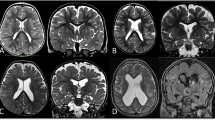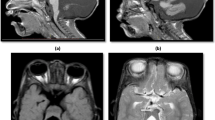Abstract
Background: Mental retardation (MR), defined as an IQ below 70, is a frequent cause of consultation in paediatrics. Objective: To evaluate the yield of brain MRI in the diagnostic work-up of unexplained MR in children. Patients and methods: The MRI features and clinical data of 100 patients (age 1–18 years) affected with non-progressive MR of unknown origin were compared to an age-matched control group (n=100). Two radiologists conducted an independent review of the MRI scans. Results: Univariate and multivariate analyses showed a higher incidence of brain anomalies in the MR group than in the control group (53 vs 17, OR=5.7 [2.9–11.1]), for signal abnormalities within the periventricular white matter (OR=20.3 [2.6–155.3]), lateral ventricular dilatation (OR=15.6 [2.0–124]), mild corpus callosum abnormalities (shortness, atrophy) (OR=6.8 [1.8–25.6]) and subtle cerebellar abnormalities, including fissure enlargement (OR=5.2 [1.1–26.2]). The diagnostic value of MRI abnormalities was considered good in 5% of patients (Alexander disease n=1, diffuse cortical malformation n=1, leukomalacia n=1, vermian agenesis n=1, commissural agenesis n=1), and weak in 48% of patients, in whom non-specific abnormalities did not lead to a diagnosis. Some clinical features resulted in a significantly higher percentage of abnormal MRI scans: abnormal neurological examination (82% vs 47%, P=0.008), abnormal skull circumference (66% vs 49%, P=0.04). Motor delay was associated with cerebellar abnormalities (P=0.01). Conclusions: This study confirms the weak diagnostic yield of MRI in mentally retarded children. The use of a control group has enabled us to identify the neuroimaging markers frequently associated with MR. Subgrouping patients according to neuroimaging markers and clinical signs should help identify those who would benefit from molecular studies.






Similar content being viewed by others
References
Kiely M (1987) The prevalence of mental retardation. Epidemiol Rev 9:194–218
Curry CJ, Stevenson RE, Aughton D, et al (1997) Evaluation of mental retardation: recommendations of a consensus conference: American College of Medical Genetics. Am J Med Genet 72:468–477
des Portes V, Livet MO, Vallee L (2002) A practical diagnostic approach to mental deficiency in 2002 (in French). Arch Pediatr 9:709–725
Majnemer A, Shevell MI (1995) Diagnostic yield of the neurologic assessment of the developmentally delayed child. J Pediatr 127:193–199
Cunningham RD Jr (1996) Neuroimaging studies in children with developmental delay. J Pediatr 128:302
O’Hayon BB, Drake JM, Ossip MG, et al (1998) Frontal and occipital horn ratio: a linear estimate of ventricular size for multiple imaging modalities in pediatric hydrocephalus. Pediatr Neurosurg 29:245–249
Barkovich AJ, Kjos BO (1988) Normal postnatal development of the corpus callosum as demonstrated by MR imaging. AJNR 9:487–491
Girard N, Raybaud C, du Lac P (1991) MRI study of brain myelination. J Neuroradiol 18:291–307
Barkovich AJ (2000) Normal development of the neonatal and infant brain, skull and spine. In: Pediatric neuroimaging, 2nd edn. Lippincott Williams and Wilkins, Philadelphia, pp 13–69
Soto Ares G, Joyes B, Lemaitre MP, et al (2003) MRI in children with mental retardation. Pediatr Radiol 33:334–345
Schaefer GB, Bodensteiner JB (1992) Evaluation of the child with idiopathic mental retardation. Pediatr Clin North Am 39:929–943
Kjos BO, Umansky R, Barkovich AJ (1990) Brain MR imaging in children with developmental retardation of unknown cause: results in 76 cases. AJNR 11:1035–1040
Gabrielli O, Bruni S, Coppa GV, et al (2002) White-matter alterations and callosal abnormalities in syndromic patients with mental retardation. J Child Neurol 17:164–168
Hirabuki N, Fujita N, Fujii K, et al (1994) MR appearance of Virchow-Robin spaces along lenticulostriate arteries: spin-echo and two-dimensional fast low-angle shot imaging. AJNR 15:277–281
Gabrielli O, Coppa GV, Manzoni M, et al (1998) Minor cerebral alterations observed by magnetic resonance imaging in syndromic children with mental retardation. Eur J Radiol 27:139–144
Rollins NK, Deline C, Morris MC (1993) Prevalence and clinical significance of dilated Virchow-Robin spaces in childhood. Radiology 189:53–57
Bouhadiba Z, Dacher J, Monroc M, et al (2000) MRI of the brain in the evaluation of children with developmental delay (in French). J Radiol 81:870–873
Bodensteiner JB, Schaefer GB, Craft JM (1998) Cavum septi pellucidi and cavum vergae in normal and developmentally delayed populations. J Child Neurol 13:120–121
Lange N, Giedd JN, Castellanos FX, et al (1997) Variability of human brain structure size: ages 4–20 years. Psychiatry Res 74:1–12
Davatzikos C, Barzi A, Lawrie T, et al (2003) Correlation of corpus callosal morphometry with cognitive and motor function in periventricular leukomalacia. Neuropediatrics 34:247–252
Fryer SL, Kwon H, Eliez S, et al (2003) Corpus callosum and posterior fossa development in monozygotic females: a morphometric MRI study of Turner syndrome. Dev Med Child Neurol 45:320–324
Kivitie-Kallio S, Autti T, Salonen O, et al (1998) MRI of the brain in the Cohen syndrome: a relatively large corpus callosum in patients with mental retardation and microcephaly. Neuropediatrics 29:298–301
Battaglia A, Bianchini E, Carey JC (1999) Diagnostic yield of the comprehensive assessment of developmental delay/mental retardation in an institute of child neuropsychiatry. Am J Med Genet 82:60–66
Shevell MI, Majnemer A, Rosenbaum P, et al (2000) Etiologic yield of subspecialists’ evaluation of young children with global developmental delay. J Pediatr 136:593–598
Botez MI, Botez T, Elie R, et al (1989) Role of the cerebellum in complex human behavior. Ital J Neurol Sci 10:291–300
des Portes V, Abaoub L, Joannard A, et al (2002) So-called ’cryptogenic’ partial seizures resulting from a subtle cortical dysgenesis due to a doublecortin gene mutation. Seizure 11:273–277
Shevell MI, Majnemer A, Rosenbaum P, et al (2000) Etiologic yield of single domain developmental delay: a prospective study. J Pediatr 137:633–637
Acknowledgements
The authors are greatly indebted to the patients and their families. The authors also wish to thank Christine André, MD, pediatric radiologist, for her assistance in performing and interpreting brain MRI, Juliette Besso for reviewing the English text, Pascale Zerbini for preparation of the manuscript and Gerard Mattéo for the photographs. This work was supported in part by a grant from the Fondation Jérôme-Lejeune.
Author information
Authors and Affiliations
Corresponding author
Additional information
Catherine Adamsbaum and Vincent des Portes have contributed equally to this work and should both be considered as last author.
Rights and permissions
About this article
Cite this article
Decobert, F., Grabar, S., Merzoug, V. et al. Unexplained mental retardation: is brain MRI useful?. Pediatr Radiol 35, 587–596 (2005). https://doi.org/10.1007/s00247-005-1406-x
Received:
Accepted:
Published:
Issue Date:
DOI: https://doi.org/10.1007/s00247-005-1406-x




